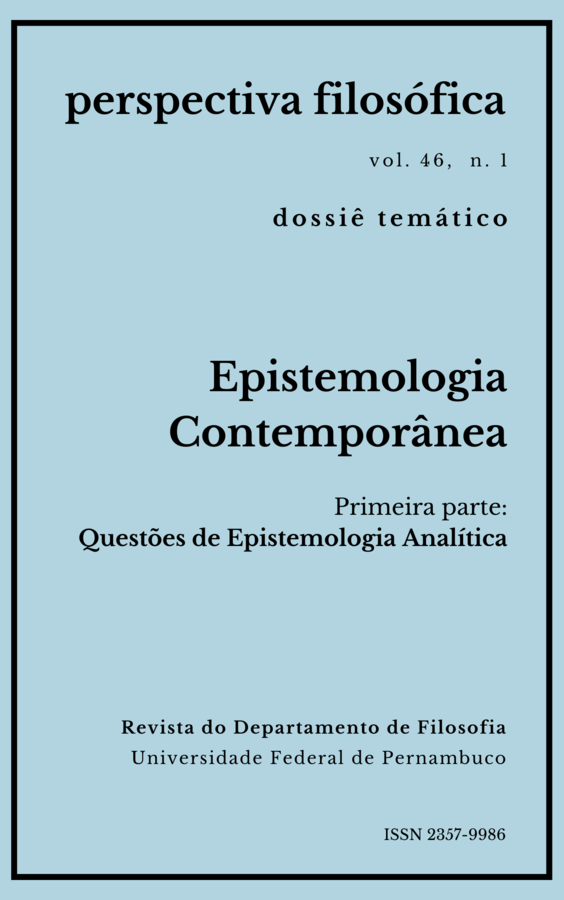Razões para a rejeição do autonomismo radical no debate acerca da avaliação moral de obras de arte
DOI:
https://doi.org/10.51359/2357-9986.2019.240738Palavras-chave:
crítica de arte, crítica moral da arte, autonomismo radical, moralismo moderado, esteticismoResumo
No caminho para a fundamentação da crítica moral de obras de arte há de se enfrentar alguns desafios ainda impostos na contemporaneidade. Este artigo valeu-se em maior parte da argumentação moralista moderada de Noël Carroll, bem como de sua compreensão acerca de como este debate deve ser levado a cabo. A posição a ser enfrentada é por ele intitulada autonomismo radical, a qual é essencialista sobre o valor da arte. Apontamos os problemas na argumentação autonomista, buscando responder ao argumento do denominador comum e ao argumento da trivialidade cognitiva. Também defendemos um pluralismo acerca do valor da arte, propondo uma visão mitigada de experiência estética, o que tem como resultado conceber o âmbito do valor artístico como englobando diversos campos de valor, sendo o estético apenas um entre os demais.Referências
ARGAN, Giulio C. Arte Moderna. São Paulo: Companhia das Letras, 1998.
BEARDSLEY, Monroe. "An Aesthetic Definition of Art". Em CURTER,Hugh (ed.). What is Art?. New York: Haven, 1983.
BEARDSLEY, Monroe. The Aesthetic Point of View. London: CornellUniversity Press, 1982.
BELL, Clive. Arte. Lisboa: Texto & Grafia, 2009.CARROLL, Noël. Art In Three Dimensions. Oxford: Oxford UniversityPress, 2010.
BELL, Clive. "Art and the Domain of the Aesthetic".British Journal ofAesthetics 40(2), 191-208, 2000.
BELL, Clive. Beyond Aesthetics: Philosophical Essays. Cambridge, UK:Cambridge University Press, 2001.
BELL, Clive. "Enjoyment, Indifference, and Aesthetic Experience".British Journal of Aesthetics 41 (1), 81-3, 2001b.
BELL, Clive. Filosofia da arte. Lisboa: Texto & Grafia, 2010b.
BELL, Clive. “Formalism”. Em GAUT, Berys & LOPES, D.M. TheRoutledge Companion to Aesthetics. London, UK: Routledge, 2003.
BELL, Clive. On Criticism. New York: Routledge, 2008.
BELL, Clive. “On the Historicaland Structure of Monroe Beardsley’sAesthetics: An Appreciation”. The Journal of Aesthetic Education, Vol. 44,No. 1, pp. 2-10, 2010c.
BELL, Clive. "Recent Approaches to Aesthetic Experience". The Journalof Aesthetics and Art Criticism Volume 70, issue 2, 2012.
BELL, Clive. (ed.). Theories of Art Today. Madison: University ofWisconsin Press, 2000b.
COOPER, David E.“Aesthetic Attitude”. Em DAVIES, S.; HIGGINS,K.M.; HOPKINS, R.; STECKER, R.; COOPER, D.E. A Companion toAesthetics (2nd ed). Oxford: Blackwell Publishing, 2009.
DAVIES, S.; HIGGINS, K.M.; HOPKINS, R.; STECKER, R.; COOPER,D.E. A Companion to Aesthetics (2nd ed). Oxford: Blackwell Publishing,2009.
DICKIE, George. “Beardsley's Phantom Aesthetic Experience”. The Journalof Philosophy, Vol. 62, No. 5 (Mar. 4, 1965), pp. 129-136.
DICKIE, George. “The Myth of the Aesthetic Attitude”. AmericanPhilosophical Quaterly 1, p. 56-65, 1964.
GIOVANNELLI, A. Artistic and Ethical Values in the Experience of Narratives (Dissertação de pós-doutorado em filosofia), University of Maryland, College Park, USA. 2004, 403 f. Disponível em:http://drum.lib.umd.edu/bitstream/handle/1903/1474/umi-umd1595.pdf;jsessionid=F2C922546C5EF48DE97129C898945FCB?sequence=1
DICKIE, George. “The Ethical Cristicism of Art: A New Mapping of theTerritory”. Philosophia 35:117–127, 2007. KIERAN, Matthew. “Art, Imagination and the Cultivation of Morals”. Em BERMUDÉZ, J & GARDNER, S. (ed.). Art and Morality, London:Routledge, 2003.
DICKIE, George. “Art, Morality and Ethics: On the (Im)Moral Characterof Art Works and Inter-Relations to Artistic Value”. Philosophy Compass ½(2006) 129-143.
DICKIE, George. Revealing Art. London: Routledge, 2004.
LEVINSON, Jerrold. Aesthetics and Ethics: Essays at the Intersection.Cambridge, UK: Cambridge University Press, 1998.
MCLAUGHLIN, Thomas M. “Clive Bell's Aesthetic: Tradition andSignificant Form”. The Journal of Aesthetics and Art Criticism Vol. 35 No.4,p.433-443, 1977.
SHELLEY, James. "The Concept of the Aesthetic", The StanfordEncyclopedia of Philosophy (Winter 2015 Edition), Edward N. Zalta (ed.),Disponível em: http://plato.stanford.edu/archives/win2015/entries/aesthetic-concept/, acesso em abril de 2016).
STECKER, Robert. Aesthetics and the Philosophy of Art: An Introduction(2nd ed). Plymouth, UK: Rowman & Littlefield, 2010.
WHEWELL, David. Aestheticism. DAVIES, S.; HIGGINS, K.M.;HOPKINS, R.; STECKER, R.; COOPER, D.E. A Companion to Aesthetics(2nd ed). Oxford: Blackwell Publishing, 2009.
WILDE, Oscar. Obras Completas. Rio de Janeiro: Nova Aguilar, 2003.
Downloads
Publicado
Edição
Seção
Licença
A Revista Perspectiva Filosófica orienta seus procedimentos de gestão de artigos conforme as diretrizes básicas formuladas pelo Conselho Nacional de Desenvolvimento Científico e Tecnológico (CNPq). http://www.cnpq.br/web/guest/diretrizesAutores que publicam nesta revista concordam com os seguintes termos:
Os autores mantém os direitos autorais e concedem à revista o direito de primeira publicação, sendo o trabalho simultaneamente licenciado sob https://creativecommons.org/licenses/by/4.0/deed.pt_BR que permite o compartilhamento do trabalho com reconhecimento da autoria e publicação inicial nesta revista.
Os autores têm autorização para assumir contratos adicionais separadamente, para distribuição não-exclusiva da versão do trabalho publicada nesta revista, com reconhecimento de autoria e publicação inicial nesta revista (Consultar http://opcit.eprints.org/oacitation-biblio.html).

Esta revista está licenciada com uma Licença Creative Commons Atribuição 4.0 Internacional.













